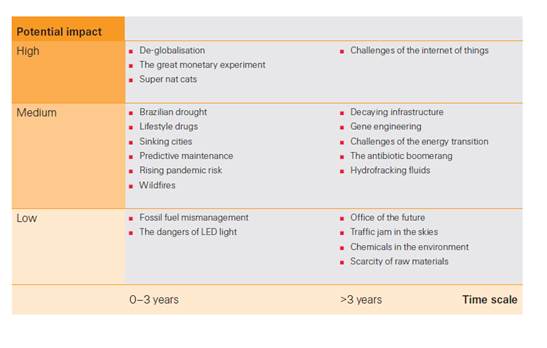A new report from Swiss Re highlights new and emerging risks the reinsurance industry expects to face over the next years. The publication is based on the SONAR process, a crowdsourcing tool to identify and evaluate new threats.
The report looks at 21 emerging risk themes, their potential impact and cascading effects across the industry.
The four emerging risks with the greatest potential impact include de-globalization, super natural catastrophes, the “great monetary experiment” and the challenge of the “Internet of Things”
Key drivers of the changing risk landscape are new economic, technological, socio-political and environmental developments as well as growing interdependencies.
 Emerging risks are newly developing or changing risks which are difficult to quantify and whose potential business impact is not yet sufficiently taken into account.
Emerging risks are newly developing or changing risks which are difficult to quantify and whose potential business impact is not yet sufficiently taken into account.
“In a future in which change is the only constant, foresight information is crucial to prepare for tomorrow’s challenges. This report seeks to provide an early indication of what might lurk beyond the horizon,” said Patrick Raaflaub, Swiss Re’s Group chief risk officer. “While many of the topics presented might never materialize into significant risks, some definitely will. The earlier we start adapting to these changes, the better prepared we will be.”
The report focuses on a wide variety of risks, relevant to life and non-life insurance areas. Highlights from this third edition include scarcity of raw materials, increased traffic in the skies, decaying critical infrastructure and the use of self-tracking tools. Pandemic risks, the proliferation of vertical cities and the dangers of LED light are also among the key highlights.
The topics presented may not only bring additional downside risk exposure, but could also give rise to new opportunities. The insurance industry could and should expand its role of mitigating others’ risks and enabling society to advance.
Source: Swiss Re
Was this article valuable?
Here are more articles you may enjoy.

 Google Contract Staff Reach Union Deal Banning Keystroke Monitoring
Google Contract Staff Reach Union Deal Banning Keystroke Monitoring  Texas Accuses Allstate-Owned Arity of Data Privacy Violations
Texas Accuses Allstate-Owned Arity of Data Privacy Violations  Amazon Ignored Its Own Worker Safety Studies, Senate Report Says
Amazon Ignored Its Own Worker Safety Studies, Senate Report Says  AccuWeather’s 2024 White Christmas Forecast Calls for Snow in More Areas
AccuWeather’s 2024 White Christmas Forecast Calls for Snow in More Areas 